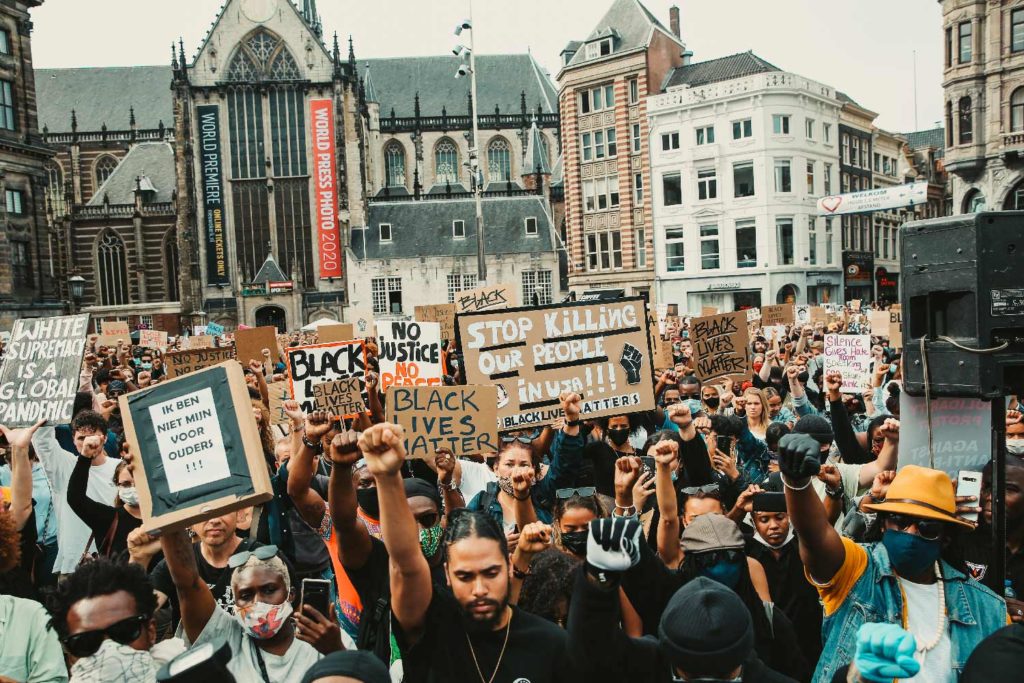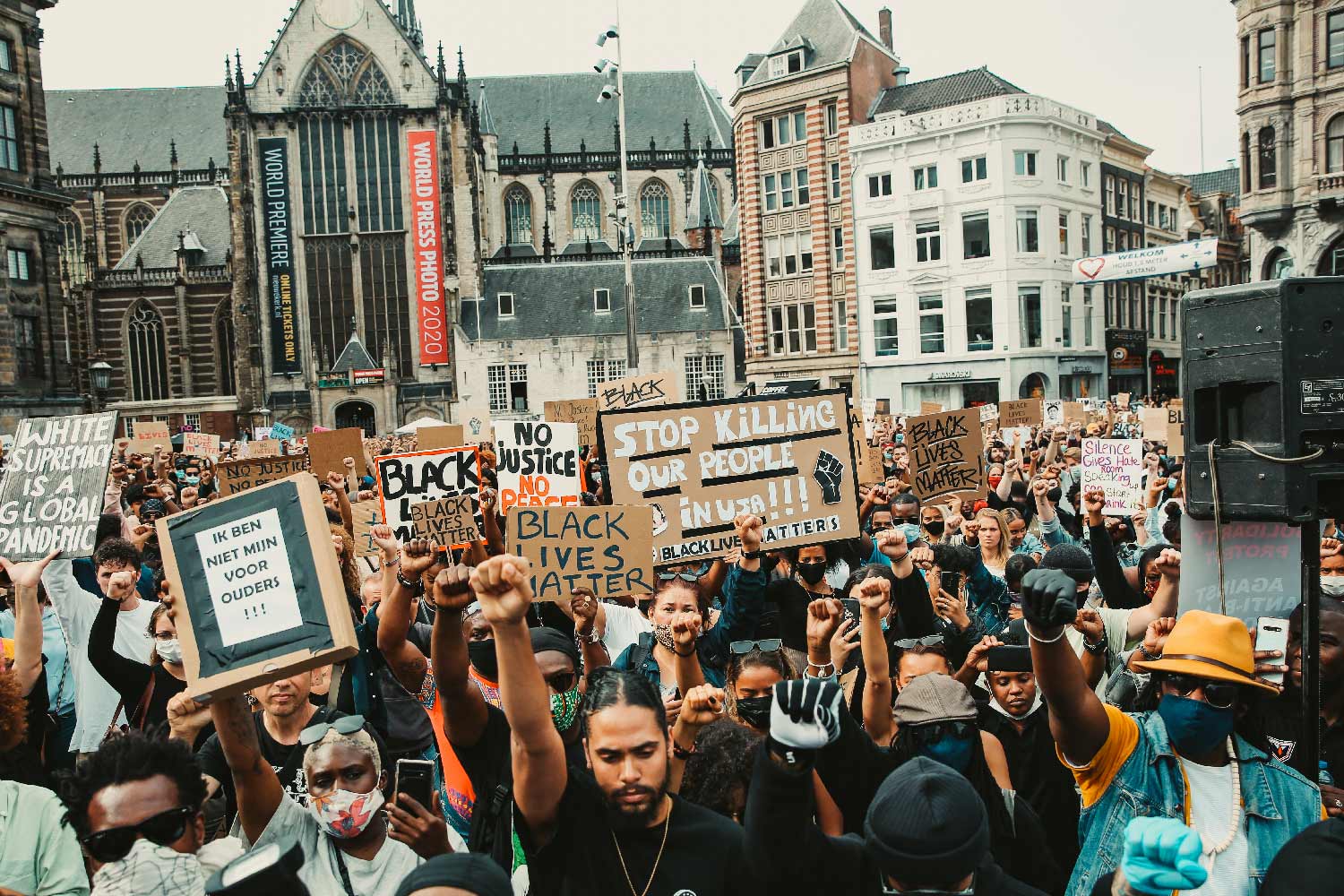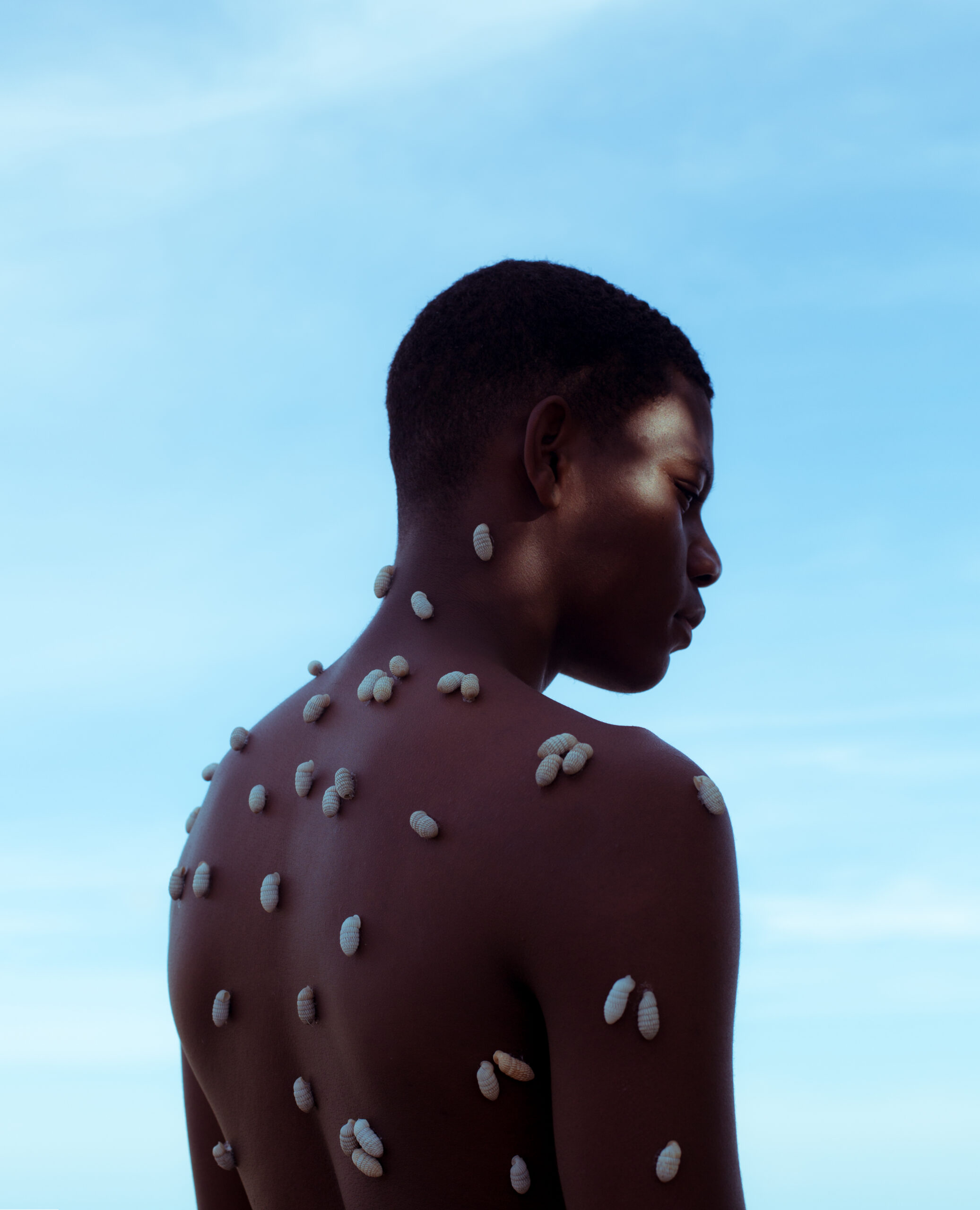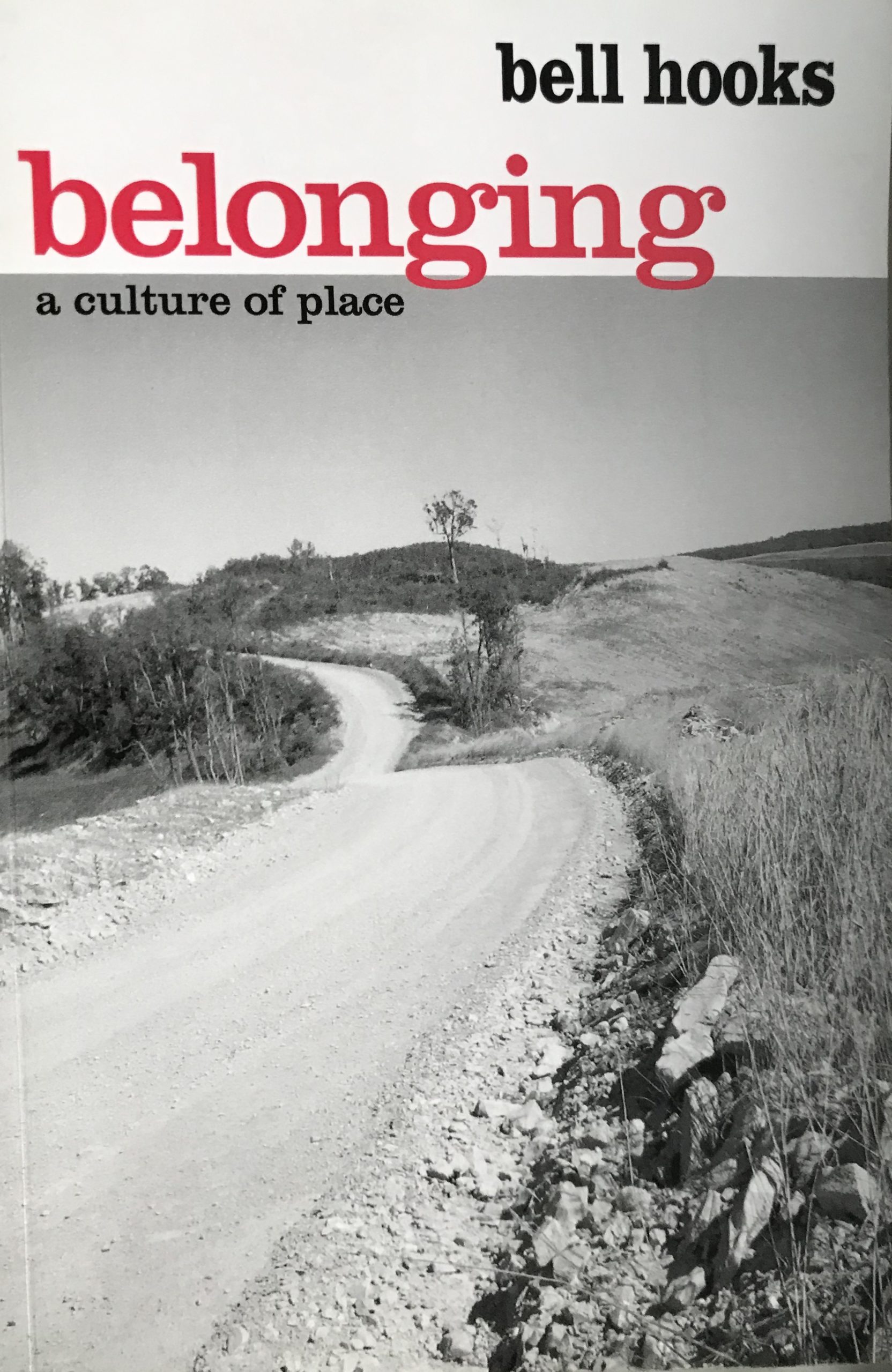essay
Refresh Amsterdam – Sense of Place An introduction
door Imara Limon, curator Amsterdam Museum
16 December 2020essay

Amsterdam is constantly on the move. The city is growing, and people come and go, bringing the world here or taking bits of the city with them. Its versatility is one of its defining characteristics, and yet its heritage has often been viewed from a white male and socially privileged perspective.

Black Lives Matter demonstration, Dam, 1 June 2020 (Photographer: Luciano de Boterman)
This seems to be slowly changing, as grassroots activists fight to achieve recognition and visibility for underexposed stories and perspectives – just look at global movements such as Pride, Black Lives Matter, and #MeToo. As one of the few black women working as a museum curator in the cultural sector, I consider it a top priority to create space for stories that are missing from the museum’s collection, for what are currently blind spots. This is important, because young people in particular derive their identity partly from the ways in which their gender, descent and religion are represented in the cultural heritage with which they grow up.
This vision fits the Amsterdam Museum. We want and need to present a more complete picture of the city that does justice to its cultural and social diversity. In our collection and exhibition practice, we have increasing attention not just for objects, but also for intangible heritage such as stories, rituals, and customs, and metropolitan topics such as migration. In 2017, together with The Black Archives in the east of Amsterdam, I created the exhibition Black and Revolutionary: The Story of Hermine and Otto Huiswoud, about the little-known story of an intellectual resistance movement in Amsterdam. Halfway through the twentieth century, when Suriname was still occupied by the Netherlands, Hermine from British Guiana and Otto from Suriname came to Amsterdam. They settled here, and fought against racism, economic inequality, and global colonisation from the headquarters of Vereniging Ons Suriname on Zeeburgerdijk. In the attic of the building was an entire archive of material documented by Hermine Huiswoud. It touched me to hear this story, perhaps due to my Surinamese roots, but particularly because it took place a stone’s throw from my former apartment. Every day I cycled past it without knowing that an important chapter in Amsterdam’s history had taken place there. I wondered what other special stories were waiting to be discovered, and who was looking for them.
‘As one of the few black women working as a museum curator in the cultural sector, I consider it a top priority to create space for stories that are missing from the museum’s collection, for what are currently blind spots.’
Amsterdam’s city culture
The contemporary perspective of artists is also central to Refresh Amsterdam, a new tradition of biennial events on urban culture. The Amsterdam Museum was looking for a way to offer interdisciplinary artists the opportunity to show work in an exhibition, write, publish, and/or organize a public program. Thus, in this first edition, we are collaborating with cultural venues throughout the city: de Appel, CBK Zuidoost, Compagnietheater, OSCAM, Rijksakademie van beeldende kunsten, SEXYLAND, and The Black Archives. Together, these partners represent a wide range of artistic disciplines.
Together we launched an open call at the beginning of 2020 for artists to submit proposals for new or recent work on the theme of this edition: Sense of Place. The selection committee consisted of representatives of the partner organizations: Aukje Dekker and Arthur van Beek (SEXYLAND), Marian Duff (OSCAM), Mitchell Esajas (The Black Archives), Imara Limon (Amsterdam Museum), Clayde Menso (Compagnietheater), Emily Pethick (Rijksakademie van beeldende kunsten), David Smeulders and Monika Szewczyk (de Appel), and Annet Zondervan (CBK Zuidoost). They were joined by writer Abdelkader Benali, whose wonderful stories are often about feeling at home and personal experiences interwoven with the political and social context. We were overwhelmed by hundreds of applications and inspired by the diverse projects and ideas: from city walks to plays, from concerts to paintings. The committee chose twenty-five proposals for what in most cases was new work.
‘Sense of Place is also about feeling at home or the experience of belonging somewhere.’
Thanks to generous contributions from various funds, we have been able to make all these projects possible. This new online platform tells you more about the exhibition in the Amsterdam Museum and the programs at the partners’ locations. There is also extensive information about the artists and their work, along with livestreams and podcasts, and you can sign up for the public program.

Refresh Amsterdam campaign image (Photographer: Kevin Osepa)
Sense of Place

Cover: bell hooks, Belonging: A Culture of Place, 1990 (2019 edition)
Sense of Place is also about feeling at home or the experience of belonging somewhere. In Belonging: A Culture of Place (1990), the American professor bell hooks, who insists on spelling her pen name in lower-case letters, writes about belonging not as a destination but as a quest, a wish. In her story, she goes back to Kentucky, in the American South, where she grew up. It is a personal quest, and at the same time she shows what happens when the contribution of an individual or group to history is forgotten, or not considered important enough to remember. In this case, black farmers become estranged from their own past, and no longer know their contribution to American agriculture, which creates a distorted picture in society. It appears as if the black community has not been a meaningful part of history. Since we all base our identities partly on questions like ‘who are you?’, ‘where are you from?’, and ‘who are your parents and ancestors?’, it does matter how particular sections of the population go down in history, and how we value and remember them. hooks shows that these issues are more complicated than a simple division between black and white; she also discusses the role of women, native Americans, rich and poor, and the relationship people have with nature.
Her writing functions as a counter-movement and an addition to the dominant image of the American countryside. Through her eyes and her personal experiences, we get an insight into the South that she carries with her, even now that she has moved to the northern United States. hooks’ work provides me with insights into my own views on migration. I recognize her changing point of view, which sways from ‘us’ to ‘them’ when she writes about people in the place where she comes from. I notice this more often in individuals who grow up with multiple cultures. After all, you have to relate to the dominant culture, where the word ‘we’ still stands for the white, masculine, heteronormative view.
New Narratives
The perspective of this dominant culture is strongly present in the language used by museums, especially those dealing with history or ethnology. Even as they increasingly express their desire to be relevant to a wider audience, the word ‘we’ usually still refers to the white western self and ‘they’ to the imaginary Other. Whether you feel at home somewhere also depends on whether you can interpret this ‘we’ differently. This starts with the realization that this simple word is context-dependent, and does not necessarily refer to the part of society that has traditionally placed itself at the centre of its attention.
In 2017, I initiated the New Narratives research program at the Amsterdam Museum, which now acts as a catalyst for inclusion throughout the organization and involves all employees. We organize experimental and interactive programs together with people who emphatically do not work in the museum, but who give critical tours and investigate what other stories can be told about items in the collection. We also invite artists to create work in dialogue with the collections from a socially engaged perspective. And we do much more, from expert meetings to neighborhood projects. The Refresh Amsterdam program is also part of New Narratives, which has grown into a long-term program line of the museum. These projects provide valuable knowledge that we incorporate into the permanent presentations, exhibitions, and programs, and new insights that are reflected in the way we work in public and behind the scenes.
All this means is that we want to show a more layered, complex picture of life in the city. For example, Open Studio(2020) by We Sell Reality, a collective of documented and undocumented artists, shows that Amsterdam’s image as a city of citizenship and social security does not always apply. How do you survive, and how are you treated, if you don’t have the right papers and aren’t allowed to work? The exhibition shows an imaginary scenario, a dream of a studio where We Sell Reality is at work. A banner hangs from a window on the facade of the Amsterdam Museum reading ‘We Are Here,’ after the refugee collective of the same name that campaigns for human rights and against the restrictions of Dutch asylum policy.
Tyna Adebowale’s work ovba (2020) offers a different perspective and a critical reflection on the common core values of Amsterdam. For her, ‘home’ is always connected to the situation in her native Nigeria where same-sex relationships are a punishable offence. Amsterdam is often associated with tolerance, but what about Happy and Esther, her Nigerian girlfriend, and Sonny and Jermain from Zimbabwe? All are queer people in Amsterdam asylum seekers’ centres, portrayed in two large paintings as they await a decision from the Dutch immigration and naturalization service. Tamara Shogaolu’s three-part transmedia animation series Queer in a Time of Forced Migration tells the personal stories of several LHBTQI+ refugees from Egypt, Sudan and Saudi Arabia, some of whom ended up in Amsterdam. Shogaolu has lived in various parts of the world, including Egypt and the Netherlands, and has followed a number of refugees since the Arab revolutions in 2011. In the museum’s attic, the works can be seen together for the first time: a film, an interactive website, and a virtual reality experience.
What do citizenship and tolerance mean for people whose situations do not conform to the prevailing norm? Where are the limits of who can be an Amsterdammer and feel at home here? Is it acceptable for Amsterdam to offer a physically safe haven for refugees, but to exclude them on a social and institutional level? And what does this mean for (in)equality of opportunity in the city? The work of these artists is powerful through its visual language that is born out of need, and that exposes the seriousness of the situations. It depicts the dream of a place to work, gives space to spirituality that provides hope for a better future, and uses animations to guarantee the storytellers’ anonymity. It invites us to take a critical look at what we can improve in the city.
Art in times of COVID-19 and #BLM
In 2020, major changes have taken place worldwide. COVID-19, and the measures taken to combat its spread, affect us all in different ways and have had a major impact on Amsterdam. The artists and collectives started to develop their work for the exhibition during the first wave, just after schools and cultural institutions closed their doors and many people had to work from home. Tirzo Martha made a sculpture about his sense of place during the pandemic. He always works in close collaboration with people around him, and this contact became difficult to achieve. The sculpture is reminiscent of a tangle of melted objects balancing on two floors of trestles. What do we actually see? A toy horse, wooden sculptures, a fluorescent tube… The work is deliberately placed close to a window so that it is impossible to walk around it to take a good look at it. It is difficult to fathom and reflects our almost desperate attempts to bridge physical and mental distance in times of corona. More than ever, we are connected through screens but physically prevented from being elsewhere.
This year has also been marked by the struggles of global movements including Pride, Black Lives Matter, and #MeToo. Since George Floyd’s death in Minneapolis on 25 May 2020, the fight against racism has been in the spotlight. In Amsterdam, which was almost empty due to the pandemic, thousands of people came to Dam Square on 1 June to demonstrate in the name of Black Lives Matter against extreme police violence and institutional racism. Ten days later, a second demonstration followed in the Nelson Mandela Park, with another large turnout. The increased societal attention for these issues offers hope for the future, but the fight is far from over. Racism is not a new phenomenon, but a complex subject deeply rooted in the social, economic, and political structures of our society. Will anything really change this time? How long will it take, and what role can we play in it?
Several artists reflect on these current developments. Raquel van Haver realizes that the anti-racism struggle in the Netherlands and around the world is in danger of being omitted from history books, and therefore portrays people who represent larger movements within this struggle. In a joint commission by CBK Zuidoost and the Amsterdam Museum, she has made an impressive life-size painting with the figures carefully arranged around a table, inspired by historical Amsterdam group portraits. Brian Elstak delved into The Black Archives during a residency there, and takes us along in this process: from making the wooden arcade cabinet and the paintings referring to his special finds in the archives – from protest songs to unique publications – to a fresh soundscape in collaboration with DJ/producer The Flexican, and MCs RFx and DenZen. B.A.S.S. Black Archives Sound System (2020) is a tribute to activists of the past and fighters of today, and brings the history of this extraordinary archive to life. In his sculptural installation ENOUGH(2020), Antonis Pittas ‘besmirches’ historical fragments of Amsterdam monumental buildings with historical and contemporary statements from the public domain, in letters of graphite and letters of marble rubble from the building fragments themselves. However ambiguous the visual language of the work may be, the title makes a clear statement.
‘Amsterdam has traditionally had a great attraction for people from all over the world. The desire to live in freedom is what unites us all.’
Amsterdam on the move
Amsterdam has traditionally had a great attraction for people from all over the world. The desire to live in freedom is what unites us all: from former to new and temporary residents, from guest workers to expats, from life-long inhabitants to visitors – we all long for a place where we feel at home, and try to realize this in different fashions. At the same time, the continuous changes in the fabric of the city mean that this aspiration is sometimes hindered and challenged. In his installation The Future of ‘Me-nemen-Mory’ (2019-2020), Suat Öğüt invites you to take a seat on carpets printed with Google Street View images of buildings hidden in the streetscape. His focus is on nineteenth-century urbanization, and on the current processes of gentrification and segregation. Migrants and former Amsterdammers are an important part of the city, but often have to move to the suburbs because of rising property prices. Öğüt planned to discuss these issues over a shared meal of the Turkish dish menemen, which unfortunately is not possible due to the coronavirus measures. Instead, he offers the recipe.
City culture is determined by people with visible and invisible connections who have to relate to one another. Artists from three textile studios in Amsterdam Nieuw-West, Bijzonder Amsterdams Atelier West, Ru Paré Community, and Buurthuis Het Anker, only got to know each other when they met last year in the neighboring de Appel art centre, with artist Hana Miletić. They learned to make solar prints together and formed the collective The Shadows Assembly. The prints are part of Gordijnwand (2019), a large curtain and a ‘’textile publication,’ both of which can be seen in the exhibition. The group’s name pays homage to domestic work and handicrafts, which are often invisible and undervalued. The Amsterdam-based collective United Painting organizes participatory projects in special public spaces around the world. They have been active in the Netherlands for a few years, working with refugees, among other things to create a home for them here. A sense of place is an integral part of United Painting’s working method, and they developed a visual identity for Refresh Amsterdam with patterns by United Painting artist Marije Lytske Hester. In collaboration with design agency Multitude, the analog patterns were digitized; an algorithm makes randomly composed new patterns that can be applied flexibly. Click on ‘refresh’, and everything is different again.
In recent months, we have sometimes wished that such a button existed for our offline world. As said, the preparations for Refresh Amsterdam coincided with the start of the pandemic. These are turbulent times in which art and culture can offer insight, reflection, and hope, and we need artists more than ever. This contrasts sharply with their precarious situation, which has become even more worrying in recent months. Their long-term uncertainties regarding health and income, social unrest, and smaller changes, for example in our way of communicating, impose extra mental and physical challenges. Many artists have lost their incomes this year. Exhibitions, performances and residencies have been postponed or cancelled, and new jobs and assignments are limited. It is precisely for this reason that we have constantly striven to keep Refresh Amsterdam going, as long as this could be done in a safe way.
At a time when there is intense debate about who we were, are and want to be, and when people in the city have a little less freedom of movement because of the corona measures, it is becoming clear that Amsterdam has endless connections with other places. The city is like a constantly changing junction between all those connections. Urban society needs creative people who can make the beautiful, and often painful, intersections tangible and tactile, in order to disentangle the knots or at least make them intelligible. To redefine our feelings for this place. Or to replace them with other feelings and imaginations that help us to pry ourselves loose from our own small surroundings and limited view. In his wonderful essay on Refresh Amsterdam, Abdelkader Benali writes that we can see artists as monsters who frighten us because they depict the city in such diverse ways that we can only hope that monsters really exist. I believe in monsters.


